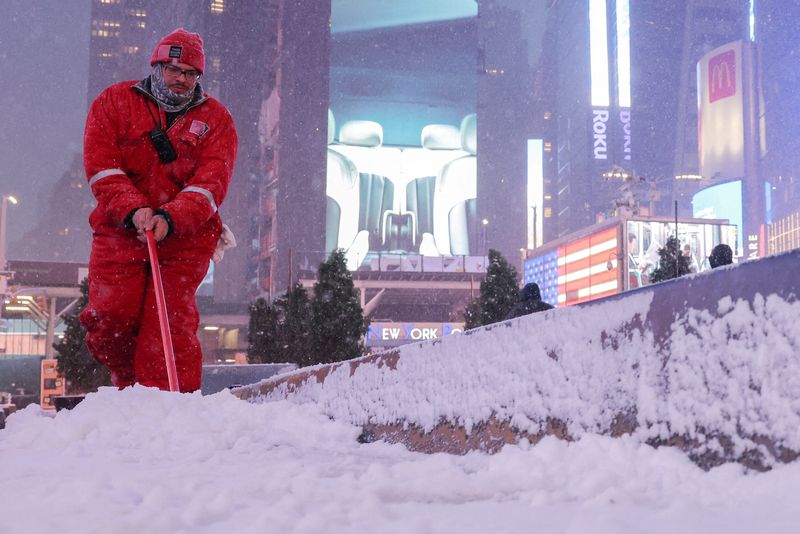Severe US cold snap prompts peak power and natural gas demand By Reuters
[ad_1]

© Reuters. A worker clears snow in Times Square during the first snowfall in over 700 days in New York City, U.S., January 16, 2024. REUTERS/Andrew Kelly/File Photo
By Deep Kaushik Vakil and Scott DiSavino
(Reuters) -Freezing temperatures in several U.S. regions triggered peak power demand in parts of the country on Wednesday, after homes and businesses consumed a record amount of for heating and power generation.
The severe winter storm dumped snow across a broad part of the country this week, shutting a Gulf Coast refinery in Texas, triggering malfunctions at others, and halving North Dakota’s oil production.
U.S. government-owned power utility Tennessee Valley Authority saw a peak demand record on Wednesday morning, when demand hit 34,526 megawatts, beating out the previous all-time high set in August 2007, the agency said.
PJM Interconnection, the largest U.S. power grid operator, covering more than a dozen states from Illinois to New Jersey, extended its cold weather advisory by a day until Jan. 22 for its western region.
Despite some isolated outages and well freezes, the country’s power and gas systems have broadly kept the lights on, and the gas flowing, avoiding the consequences of a deadly storm three years ago.
A February freeze in 2021 left millions in Texas and other U.S. Central states without power, water and heat for days and caused more than 200 deaths.
The Electric Reliability Council of Texas (ERCOT), which operates most of the state’s power grid, was forced at the time to impose rotating power outages to prevent a grid collapse after an unusually large amount of generation shut due in part to a lack of fuel.
This time ERCOT mustered enough generating supplies to meet record winter demand so far during this storm thanks in part to energy conservation efforts by Texas electricity customers.
As this week’s extreme cold moves into the U.S. Northeast, spot power and gas prices in New York and New England jumped to their highest levels since February 2023.
U.S. GAS DEMAND HITS RECORD
U.S. gas demand jumped to a preliminary 167.8 billion cubic feet per day (bcfd) on Tuesday, financial firm LSEG said. That would top the previous all-time high of 162.5 bcfd set in December 2022 during Winter Storm Elliott, according to federal energy data from S&P Global Commodities Insights.
Meanwhile, U.S. gas output dropped by 17.0 bcfd from Jan. 8-16 to 90.6 bcfd on Tuesday, its lowest since December 2022, according to LSEG, due primarily to freeze-offs, which occur when wells, pipes and other equipment freezes.
That output decline was still smaller than gas supply losses of around 19.6 bcfd during Winter Storm Elliot in December 2022 and 20.4 bcfd during the February 2021 freeze.
One billion cubic feet of gas is enough to fuel about 5 million U.S. homes for a day.
[ad_2]
Source link

© Reuters. A worker clears snow in Times Square during the first snowfall in over 700 days in New York City, U.S., January 16, 2024. REUTERS/Andrew Kelly/File Photo
By Deep Kaushik Vakil and Scott DiSavino
(Reuters) -Freezing temperatures in several U.S. regions triggered peak power demand in parts of the country on Wednesday, after homes and businesses consumed a record amount of for heating and power generation.
The severe winter storm dumped snow across a broad part of the country this week, shutting a Gulf Coast refinery in Texas, triggering malfunctions at others, and halving North Dakota’s oil production.
U.S. government-owned power utility Tennessee Valley Authority saw a peak demand record on Wednesday morning, when demand hit 34,526 megawatts, beating out the previous all-time high set in August 2007, the agency said.
PJM Interconnection, the largest U.S. power grid operator, covering more than a dozen states from Illinois to New Jersey, extended its cold weather advisory by a day until Jan. 22 for its western region.
Despite some isolated outages and well freezes, the country’s power and gas systems have broadly kept the lights on, and the gas flowing, avoiding the consequences of a deadly storm three years ago.
A February freeze in 2021 left millions in Texas and other U.S. Central states without power, water and heat for days and caused more than 200 deaths.
The Electric Reliability Council of Texas (ERCOT), which operates most of the state’s power grid, was forced at the time to impose rotating power outages to prevent a grid collapse after an unusually large amount of generation shut due in part to a lack of fuel.
This time ERCOT mustered enough generating supplies to meet record winter demand so far during this storm thanks in part to energy conservation efforts by Texas electricity customers.
As this week’s extreme cold moves into the U.S. Northeast, spot power and gas prices in New York and New England jumped to their highest levels since February 2023.
U.S. GAS DEMAND HITS RECORD
U.S. gas demand jumped to a preliminary 167.8 billion cubic feet per day (bcfd) on Tuesday, financial firm LSEG said. That would top the previous all-time high of 162.5 bcfd set in December 2022 during Winter Storm Elliott, according to federal energy data from S&P Global Commodities Insights.
Meanwhile, U.S. gas output dropped by 17.0 bcfd from Jan. 8-16 to 90.6 bcfd on Tuesday, its lowest since December 2022, according to LSEG, due primarily to freeze-offs, which occur when wells, pipes and other equipment freezes.
That output decline was still smaller than gas supply losses of around 19.6 bcfd during Winter Storm Elliot in December 2022 and 20.4 bcfd during the February 2021 freeze.
One billion cubic feet of gas is enough to fuel about 5 million U.S. homes for a day.